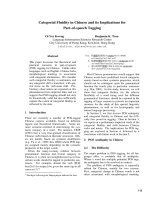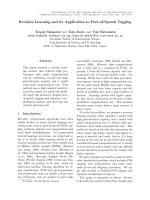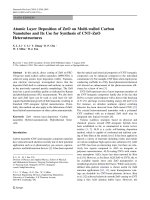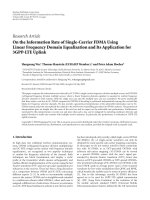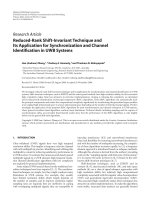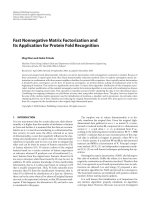Modeling the Human Face and its application for Detection of Driver Drowsiness
Bạn đang xem bản rút gọn của tài liệu. Xem và tải ngay bản đầy đủ của tài liệu tại đây (564.32 KB, 4 trang )
International Journal of Computer Science and Telecommunications [Volume 3, Issue 11, November 2012] 56
Journal Homepage: www.ijcst.org
Lam Thanh Hien
1
, Tran Van Lang
1,2
, Ha Manh Toan
3
, Do Nang Toan
3
1
Faculty of Information Technology, Lac Hong University, Vietnam
2
Institute of Applied Mechanics and Informatics, Vietnam
3
Institute of Information Technology, Vietnam
, , ,
Abstract—The detection problem of human face in the image
has been studied since the 70s. However, this is a complex
problem so there are many research groups on the world
interested. In the detection of human face, the pattern of the
human in the image, which is a concept showing the relationship
between the image information with a human face that
definition. The one of paper results is to give a human face model
in the space approach, which can detect some states face. From
that the paper proposed an algorithm to detect driver
drowsiness. The algorithm has been implemented and tested, and
it proved effective in cases where the image was taken a direct
and bright enough.
Index Term – Image Processing, Human Face Recognition and
Driver Drowsiness
I. INTRODUCTION
HE research on human faces in images is a topic, which
has long interested in the field of computer vision.
Which detects human faces in images is a problem
throughout and always attracted the attention of many
research groups around the world.
In fact, there are many problems need to face recognition
such as face detection is integrated in the digital camera; the
application of access control based on facial recognition is
located at the airport, train stations; the application to monitor
and track human through the use of camera systems are
located in a building or a certain security area; the Hollywood
epic film in which the face of actors are transformed into new
shapes that we have not heard before like the werewolf,
vampire, avatar.
Moreover, in addition to widespread application; this is a
difficult problem, not the final solution. In the area of face
recognition, the face model in the picture is important research
problem. It is a concept showing the relationship between the
image information with a definition of the person. One of
approaches to model the human face is a combination of
geometric features and material characteristics of faces in
images based on statistical methods.
The Fig. 1 is Eigenface model; this is the characteristic
vector model in face recognition. This model is based on
technical on Principal Component Analysis (PCA), in which
each pixel is treated as a random variable. To reduce the
volume of calculations, Matthew Turk and Alex Pentland [3]
gave a formula to reduce the dimensionality of the covariance
matrix when calculating the eigenvector and eigenvalue. This
model has become popular, not only by the relatively high
accuracy, range 60 ~ 90% in many published data on the
network, but also because it is quite flexible in the application.
This approach is based on building a statistical model for
human face shape, and on that basis to build statistical models
for human images material, after that synthesizing to create the
human face model
The learning and estimation of the parameters for the model
to minimize the error function by an optimization iterative
method. The basic objectives of the human face model based
on this approach are the analysis and synthesis of human faces
in images under specific requirements. According to this
research, there are models such as ASM (Active Shape Model)
and AAM (Active Appearance Model) given by Cootes (Fig. 2
and Fig. 3).
Figure 1. Model Eigenface of Matthew Turk and Alex Pentland
T
Modeling the Human Face and its Application for
Detection of Driver Drowsiness
ISSN 2047-3338
Lam Thanh Hien et al. 57
This paper gives a human face model for Vietnamese adults
by spatial structure. Based on the classification and inheritance
as enginface model for the human eye, which can determine
the state faces. Since this model is given, we propose an
algorithm to detect driver drowsiness. The result has been
installed and tested proved quite effective.
Figure 2. Optimization iterative process of ASM
Figure 3. Optimization iterative process of AAM
The rest of the paper is shown as follows: Section 2 presents
a human face model in the image. Section 3 is the algorithm to
detect driver drowsiness. The next section presents the
experimental results and the conclusion was presented in
finally section.
II. THE HUMAN FACE MODEL IN IMAGES
A. The human face in image
The human face in the image is a region that shows the
human face. Finding it in the image is the final result of the
human face-detecting problem; it is also the input data for
human face recognition problem. Data of the human in image
should be analyzed to optimize for efficient use of face
detection, which uses the above mentioned human face model.
For example, in the problem detects the drowsy driver is
discussed in this paper, the human face image is a face that
looks slightly face up; face with square frames, edge size of
about 100 ~ 200 pixels (Fig. 4).
Figure 4. The human face image
In the face area usually appears only at a human face; in
this case there are than a one, the face of the driver is the
biggest, and the other faces usually smaller because they are in
the rear.
B. The eye human in image
For a human face, there may be many people in the frame
but for the human eye in the frame, only one eye. In the
drowsiness detection problem of a driver, the eye image is
defined as a square image; it includes the eye and brow area
above the eyes, its edge size is about 25 ~ 50 pixels. In the
case open eye, the pupil area is approximately 30 pixels,
located at 1/3 of image from the bottom area (Fig. 5)
Figure 5. Area of eye in image
There have been many researches of the status of the eye,
such as gaze detection and blink detection. The gaze detection
focuses on the eye-opening case and analyses of the position of
the pupil in the eye; while the blink detection often focus on
the change of the eye image, without regard to the eye is
closed or opened (Fig. 6).
This paper considers only the most basic two states of the
eye: closed and opened. To determine this status, the paper
uses the eye image data as the input of SVM (Support Vector
Machine) to be class as between two states of the eye.
Figure 6. Eye Model of Eigenface
C. The spatial approach of human face model
To optimize the parameters of the model that corresponds to
the faces of the Vietnamese, we refer to the anthropometric
signs of Vietnamese adults [1]. The Information on
anthropometric was measured in people are shown in Table 1.
Table 1. Data of Vietnamese face
Subjects
Students and Free workers in
Hanoi, Bac Giang
Quantity
959 persons
Age
From 18 to 55
Sex
Male: 460 Female: 499
Hometown
Hanoi, Bac Ninh, Bac Giang,
Nam Dinh, Thanh Hoa
International Journal of Computer Science and Telecommunications [Volume 3, Issue 11, November 2012] 58
Based on anthropometric signs that have been statistied and
analyzed correspondently to four basic models of the
Vietnamese face (Fig. 7), the paper has built the corresponding
parameters for the human face model.
Square Face Tip Face
Oval face Round face
Figure 7. Four Vietnamese face models
This paper presents a simple model but effective to detect
quickly and accurately the human face, as well as the face
components based on the analysis of face and location of the
human face components in the image.
The human face model includes the limited areas of the face
and the face components. To estimate the parameters of the
model, we need to analyze in detail the location of human face
images.
In the drowsiness detection problem of driver, there should
be a camera mounted in front of the driver, and set marginally
below that it does not interfere with the driver's vision. The
camera angle was fixed, the driver seat position is also fixed
and the driver always looks straight ahead. So in the frame of
the camera obtained human face image that always face
straight and slightly from below.
In this human face image area, the eyes appear in rectangle
with size (le_w_1, le_w_2) x (ep_h_1, ep_h_2), similar with
right eye, from re_w_1 to re_w_2.
The nose appears in the rectangle (n_w_1, n_w_2) x (n_h_1,
n_h_2).
The mouth is located under the nose; it is in the range of
(m_w_1, m_w_2) of face image.
By defining the parameters used this simple model, the
search space is reduced a lot. Since it is very easy to build face
detection component for detecting problem the drowsy driver.
III. THE ALGORITHM OF DROWSINESS DETECTION
A. The drowsiness status
The drowsiness status of driver is determined by the eyes
closed continuously in predetermined time duration; it is
measured in seconds or frames.
B. The algorithm
Objective: Determine the eyes in the frame is closed or
opened.
Input: image I (is frame be taken from the camera or
video file)
Output: -1/0/1 (no face/closed eyes closed/opened eyes)
Variables:
o Region: face_region, eyepair_region,
lefteye_region, righteye_region, face,
eyepair, lefteye, righteye;
o List<Region>: face_list;
o EdgeMap: face_edge;
o Integer: model_id;
o FaceModel: model;
The steps:
Step 1: Determine the face
o face_region = GetFaceRegion(I);
o Normalize(face_region, I);
o face_list = DetectFaces(face_region, I);
o if size_of(face_list) = 0, return -1;
o face = GetBiggestObject(face_list);
o Segment(face, I);
o face_edge = ProcessEdge(face, I);
o model_id = RecognizeModel(face_edge);
o model = GetFaceModel(model_id);
Step 2: Determine the eyes
o eyepair_region = GetEyePairRegion(face,
model);
o eyepair = DetectEyepair(eyepair_region, I);
o if eyepair = null, return -1;
o lefteye_region = GetLeftEyeRegion(eyepair,
model);
o lefteye = DetectLeftEye(lefteye_region, I);
o if lefteye = null, return -1;
o righteye_region = GetRightEyeRegion(eyepair,
model);
o righteye = DetectRightEye(righteye_region,
I);
o if righteye = null, return -1;
Step 3: Recognize the eye status
o NormalizeEyes(I, lefteye, righteye);
o if IsClosedEye(I, lefteye) or IsClosedEye(I,
righteye), return 0;
else return 1;
The complexity of the algorithm is O(n
3
), so that model
optimization to reduce the search window is very important for
detecting problem.
IV. EXPERIMENTAL RESULTS
The testing program is built on Visual C++ with Library
OpenCV fro Intel. The program receives input data from the
source video or webcam, and then notifies the faces state of
driver. Program data were collected in several different
conditions such as laboratory, in cars. The experimental
results show that the program runs with real-time speed and
accuracy is very high in testing data set (Table 2, Fig. 8).
Lam Thanh Hien et al. 59
Table 1. The parameter for testing
Square face
Tip face
Oval face
Round face
ep_h_1
0.142857
0.166667
0.142857
0.166667
ep_h_2
0.433333
0.500000
0.433333
0.500000
le_w_1
Left_eyepair
Left_eyepair
Left_eyepair
Left_eyepair
le_w_2
(Left_eyepair+Ri
ght_eyepair)/2
(Left_eyepair
+Right_eyep
air)/2
(Left_eyepair
+Right_eyep
air)/2
(Left_eyepair
+Right_eyep
air)/2
re_w_1
(Left_eyepair+Ri
ght_eyepair)/2
(Left_eyepair
+Right_eyep
air)/2
(Left_eyepair
+Right_eyep
air)/2
(Left_eyepair
+Right_eyep
air)/2
re_w_2
Right_eyepair
Right_eyepai
r
Right_eyepai
r
Right_eyepai
r
n_w_1
0.333333
0. 333333
0. 333333
0. 333333
n_w_2
0.666667
0. 666667
0. 666667
0. 666667
n_h_1
Bottom_eyepair
Bottom_eyep
air
Bottom_eyep
air
Bottom_eyep
air
n_h_2
0.723333
0.750000
0.723333
0.750000
m_w_1
0.250000
0.250000
0.250000
0.250000
m_w_2
0.750000
0.750000
0.750000
0.750000
Figure 8. Experimental result
V. CONCLUSION
The face model is a concept that has many applications is
deployed. However there are still many open issues. This
paper gives a simple model to apply for detection quickly and
accurately the faces and facial components. Form that to use
for drowsiness detection of drivers. This paper is limited in
terms of data collected enough light.
ACKNOWLEDGMENT
We would like to thank colleagues in the Laboratory of
Virtual Reality, Institute of Information Technology, Vietnam
Academy of Science and Technology, that they provided us
with valuable data to test the program.
REFERENCES
[1] Nguyen Trong Toan, Studying the anthropometry signs of
Vietnamese adult for facial reconstruction from skulls, 2011
(Vietnamese Language)
[2] Erik Murphy-Chutorian, Mohan Manubhai Trivedi. Head Pose
Estimation in Computer Vision: A Survey, IEEE Transactions on
pattern analysis and machine intelligence, 2009
[3] Matthew Turk, Alex Pentland, Eigenface for Recognition, Journal
of Cognitive Neuroscience, 3:16, 1991.
[4] Ming-Hsuan Yang, David J. Kriegman, et al., Detecting Faces in
Images: A Survey, IEEE Transactions on pattern analysis and
machine intelligence, 24, 2002.
[5] Neeta Sarode, Shalini Bhatia. Facial Expression Recognition.
International Journal on Computer Science and Engineering 2,
2010, p. 1552-1557.
Lam Thanh Hien received the MSc. Degree in Applied
Informatics Technology in 2004 from INNOTECH
Institute, France. He is currently working as a vice-rector
at Lac Hong University. His main research interests are
Information System and Image Processing.
Tran Van Lang is Associate Professor in Computer
Science of Vietnam Academy of Science and
Technology. He received BSc. Degree in Mathematics
in 1982 and PhD in Mathematics – Physics in 1995 from
HCM City University of Natural Science, Vietnam. He
also worked at Dorodnitsyn Computing Center, Russian
Academy of Science. He is currently working as
Associate Professor in Computer Science at a research institute of Vietnam
Academy of Science and Technology; and as Dean of Faculty of Information
Technology, Lac Hong University. His main research interests are High
Performance Parallel and Distributed Computing, Bioinformatics, Scientific
Computation and Fuzzy Computing Methods. He is IEEE Member with No.
Number is 90579642.
Ha Manh Toan received the BSc. Degree in Applied
Mathematics and Informatics in 2009 from College of
Science, Vietnam National University, Hanoi. He is
currently working as a researcher at Institute of
Information Technology, Vietnamese Academy of
Science and Technology. His main research interests are
Image Processing, Computer Vision.
Do Nang Toan is Associate professor in Computer
Science of Vietnam Academy of Science and
Technology. He received BSc. Degree in Applied
Mathematics and Informatics in 1990 from Hanoi
University, and PhD in Computer Science in 2001 from
Vietnam Academy of Science and Technology. He is
currently working as a Head of Department of Virtual
reality technology at Institute of Information Technology, Vietnamese
Academy of Science and Technology and as Dean of Faculty of Multimedia
Communications, Thai Nguyen University of Information and
Communication Technology. His main research interests are Pattern
recognition, Image processing and Virtual reality.
